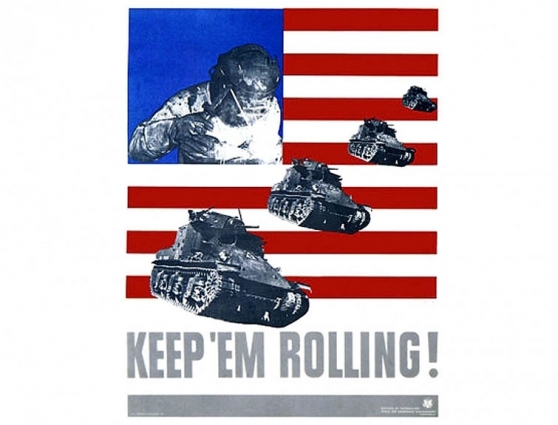World War Two - Weapons and Inventions
World War Two Film Clips 
"Soldiers respect for this weapon traces to two things. It fires .45 caliber slugs as a cyclical rate of 600 to 700 per minute. An enemy struck by a carbine or riffle bullet can keep coming - as Japs have shown. A man struck by a Tommy Gun slug is stopped dead in his tracks. A burst of fire can cut a man in two." "Six-pounder guns are being turned out in large numbers in one of the Royal Ordnance factories in England. Most of the workers who make them are women. The gun is highly mobile and is said to have a high rate of fire and remarkable armor penetration." "'We're so far ahead of that Heinie in tank design and production that he's never going to catch us' - that was the opinion expressed by Major General Levin H. Campbell (1886 - 1976), the War Department's Ordnance Chief, in an interview in New York last week. He quoted a British officer as saying that the American M-4 General Sherman tank is the 'answer to a tankman's prayer.'"
When General Marshall listed the numerous advantages that the U.S. Army enjoyed during the war (you can read it here), he included on his list the Willys Jeep. The Jeep and the Two and Half-Ton truck, he believed, contributed mightily to the mobility of American Forces in most theaters. The two articles attached herein go into some detail about the strengths of the Jeep, but concentrated primarily on the improvements made in the vehicle as Jeep prepared for its launch in the civilian market place. This article tells of the U.S. Army Ordnance Corps and how they go about turning enemy weaponry inside-out in order to gain a full understanding of Axis capabilities:
"Every gun, from the smallest side-arm to largest howitzer, every tank, truck or other conveyance, every airplane and item of equipment abandoned by the retreating enemy, whether it be emergency ration or new type haversack falling into Allied hands, is carefully scrutinized for tell-tale clues to [the] foe's tactics and resources." "Soon after Pearl Harbor Americans began hearing about a Japanese warplane called called the Zero. It had an unusual name, it was virtually unknown, even to aircraft experts, and almost immediately it began to take on an air of sinister mystery. Information now available shows there is no good reason for the mystery, although the plane has been a big factor in the Jap drive... The Zero has no secret weapons or engineering developments. It is simply a pretty good pursuit or fighter." |
MORE ARTICLES >>> PAGE: * 1 * 2 * 3 * 4 * 5 * 6 * 7 * 8 * 9 * > NEXT |
|